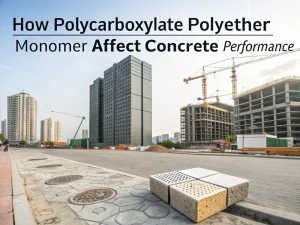Blog
In the field of construction engineering, strength is the lifeline of concrete. The compressive strength of concrete is the cornerstone for ensuring structural safety, reliability, and longevity, from the magnificent columns that support skyscrapers to the cross sea bridges that carry busy traffic. Although traditional cement, sand, stones, and water form the foundation of concrete, in order to elevate its strength to excellence, we need to harness the power of modern chemistry, and concrete admixtures are used to enhance its strength.
These concrete additives for strength optimize the internal structure of concrete in different ways, significantly improving its final performance.
This article will delve into several key types of concrete admixtures used to enhance strength, and reveal how they transform standard concrete into high-performance materials.
Before discussing any admixture, it is necessary to understand the first rule of concrete strength: the Water-Cement Ratio.
The lower the water-cement ratio, the higher the strength.
This is because the amount of water required for the cement hydration reaction is limited. Any excess water will evaporate after the concrete hardens, leaving tiny pores that are the weak points in the structure.
However, the problem is that too little water can cause the concrete to become dry, hard, sticky, and almost impossible to construct. Therefore, the core strategy for enhancing strength is to minimize the water-cement ratio as much as possible while maintaining good workability.
This is where most strength-enhancing admixtures come into play.
Silicon powder is a byproduct of metal silicon production, composed of ultrafine glass particles (100 times smaller than cement particles).
How do they enhance strength?
Result: The strength has been greatly improved, and ultra-high-strength concrete exceeding 100 megapascals (15000 psi) can usually be easily manufactured, while its durability is unparalleled.
Fly ash is a byproduct of coal-fired power plants and an economically efficient strength and durability enhancer.
How do they enhance strength?
Fly ash also has volcanic ash activity and can react with calcium hydroxide for weeks to months to generate additional cementitious substances, thereby contributing to the later strength of concrete. In addition, its spherical particles can improve the workability of concrete, playing a role similar to a “ball” and helping to reduce water demand.
Result: Although the early strength may be slightly lower, the long-term strength of concrete will continue to increase after 28 days and significantly improve its resistance to chemical erosion and infiltration.
GGBS is a byproduct of the steel industry, which itself has cementitious properties.
How do they enhance strength?
GGBS can replace most cement and undergo hydration reactions on its own. Its reaction speed is slower than that of cement, thus helping to reduce early hydration heat and providing impetus for sustained strength growth in the later stage.
Result: Similar to fly ash, GGBS can significantly improve the long-term strength and durability of concrete, especially in resisting sulfate and chloride ion erosion.
Superplasticizer is a chemical additive that can reduce the moisture content while maintaining processability.
How do they enhance strength?
By reducing the water-cement ratio (which is crucial for strength), superplasticizers can produce concrete with fewer pores and higher density. For example, reducing 30% moisture can increase strength by 20-50%.
Strength gain: When used in conjunction with bonding materials such as silica fume, high-strength concrete (6000-12000 psi) can be achieved.
Usage: Skyscrapers, precast concrete, and self compacting concrete (SCC) for complex structures.
Dosage: 0.5-3% of cement weight (polycarboxylate superplasticizer is the most effective type).
Steel fiber is a reinforcing additive that can increase the tensile strength (the weak point of concrete).
How do they enhance strength?
Fiber evenly distributes stress to prevent crack propagation. They increased the flexural strength by 20-100% and reduced shrinkage cracking.
Strength gain: increase tensile strength by 30-50%; Very suitable for floor slabs, tunnels, and industrial flooring.
Usage: Heavy duty flooring, shotcrete (sprayed concrete), and seismic resistant structures.
Dosage: 0.5-2% of the volume of concrete (length range 10-60mm).
CAC is a special cement additive that hardens quickly and has high early strength.
How do they enhance strength?
Reacts with water to form calcium aluminate hydrate, which sets faster and has a higher density than traditional Portland cement.
Intensity gain: Early intensity (1 day) up to 4000 psi; Very suitable for quick repairs.
Usage: Emergency maintenance, cold weather construction, and high-temperature environments (such as industrial furnaces).
Dosage: Mix with Portland cement (20-50% CAC) to achieve balanced strength and setting time.
By wisely selecting one or more concrete additives for strength, engineers can break through the limitations of traditional materials. Whether using high-efficiency water reducing agents to achieve ultimate compactness or using silica fume and fly ash to build long-term toughness, these additives are the key to modern buildings achieving unprecedented heights, spans, and durability. They are the cornerstone that ensures our future infrastructure is stronger and more sustainable.

How Polycarboxylate Polyether Monomer Affect Concrete Performance
Blog How Polycarboxylate

How Polycarboxylate Superplasticizer Interacts With Slag In Concrete
Blog How Polycarboxylate